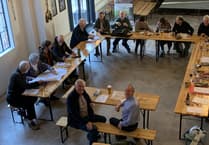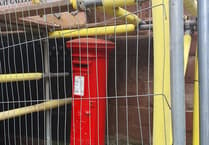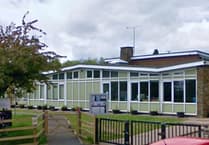Vaga Probus Club- the ups and downs of bellringing
Seats were at a premium for the second Vaga Probus meeting in April when four Vaga members entertained and educated their fellow members with an insight into the intricacies of the ‘exercise’.
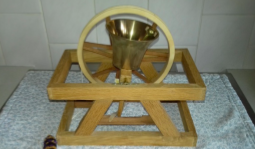
First up was Robin Noble who gave an entertaining summary of the history of bells starting with cowbells and covering the monastic movement, the Dissolution of the Monasteries, the Civil War and the Restoration and how bells and bellringing were affected. We also learned the origin of words like "campanology" and "clock". He finished with a glance at the world view and looked forward to an encouraging future for our bells.
Herbie Renfield then explained how bells were hung in a church tower, with the aid of a model made by Robin. He particularly drew the audience’s attention to the ‘stay’, the piece of wood that allows the bell to be ‘parked’ upside down during a ringing session whilst the ringers have a rest, usually to eat chocolate. Breaking a stay is a rite of passage for learner ringers and Herbie produced the one that he had broken whilst learning.
Greg White then explained how bells were rung and, by using an animated cartoon, was simultaneously able to show both the bell and the ringer and demonstrate the techniques involved in controlling the action of the bells so that they might be rung in different sequences.
Herbie then introduced the audience to the idea that the noises coming out of a bell tower were not just a random cacophony designed to annoy the neighbours but sequences that had a very strict pattern. Not repeating a ‘sequence’ and not moving a bell more than one place between sequences are the two big rules. The number of variations that can be rung on bells is surprising: four bells can only be rung in 24 different ways but there are two hundred ways that these can be rung obeying the two rules – but 6 followed by twenty three zeroes if the rules are ignored!
Greg then illustrated how bells are used not only as a call to prayer, but also to mark the big occasions in society.
The talk concluded with Geoff Woodyatt explaining the history of Tower Grabbing, which is the planned or chance ringing of Church Bells in any church bell tower other than your home tower. Geoff said that recorded Tower Grabbing had been going on since 1733 through to the present day and concluded his talk with a personal
experience of a grab by his wife Pam and himself in St Paul’s Cathedral in the city of Melbourne, Australia, where they had received a warm welcome and an invitation to ring. It was agreed that this was one which will never be done again.
In conclusion, it was pointed out that to ring you did not have to be musical or strong, young and old can participate [although the steps up towers could be testing on the knees] and a ringer could be of any faith or none.
Vaga Probus is a men’s group that meets twice a month in Ross. Visitors are very welcome. If you have an interest in visiting or indeed have a talk you would like to deliver, please contact the Secretary on [email protected]. Further details are on the website at www.vaga-probus-ross.org.uk
In the Parishes
Ross Parishes continues to foster a sense of community and spiritual nourishment with a diverse range of events and activities scheduled for the upcoming week. From virtual prayers to physical gatherings, there’s something for everyone seeking solace and connection.

On Wednesday, May 1:
8:45-10:15am: Kickstart your day with Toast & Toddle at St Mary’s—an opportunity for parents and toddlers to come together for a morning of fun and companionship.
11:45am: Ponder and Pray. Contact [email protected] fr more information.
1pm: The Lunchtime Concert with Northwick Consort at St Mary’s.
1:45pm: Mother’s Union at St Mary’s Hall.
On Thursday, May 2:
10:00am: Attend the Eucharist at Markye Chapel, St Mary’s, to partake in a solemn communion.
11:45am: Connect with the St Mary’s Thursday Prayer group via Zoom. Visit rossparishes.uk/worship/prayer for participation details.
On Friday, May 3:
6:30pm-7:30pm: Join the Youth Choir rehearsal at St Mary’s—a platform for young voices to harmonise and express themselves.
7:00-8:00pm: Fine-tune your vocal talents at Choir practice, also held at St Mary’s.
On Saturday, May 4;
Between 10:30am and 12pm noon: The Coffee & Sgwrs at St Mary’s.
On Sunday, May 5:
8:00am: Commence the day with Holy Communion at St Mary’s, a tranquil service steeped in tradition and reverence.
At 9:30am is the All Age Eucharist at St Mary’s which will also be live streamed.
Also at 9:30am: The parish Eucharist at St Michael’s, Walford.
11am: GROW Youth Group at St Mary’s Hall.
On Monday, May 6:
12 noon: Prayers for St Mary’s at St Mary’s.
On Tuesday, May 7:
9:00-11:00am: Tea & Toast and browse the Community Larder at St Mary’s Hall—a welcoming space for nourishment and fellowship.
Ross Parishes invites all members of the community to partake in these enriching experiences, fostering connections and nurturing the spirit.
A thanks to Hereford Grass Cutting Operatives
One Ross-on-Wye resident has thanked the Hereford Grass Cutting Operatives for their recent work.
Barbara Nash was impressed with the sympathetic way the Hereford Grass Cutting Operatives strimmed the grass verge at the entrance of the cul-de-sac she lives in.
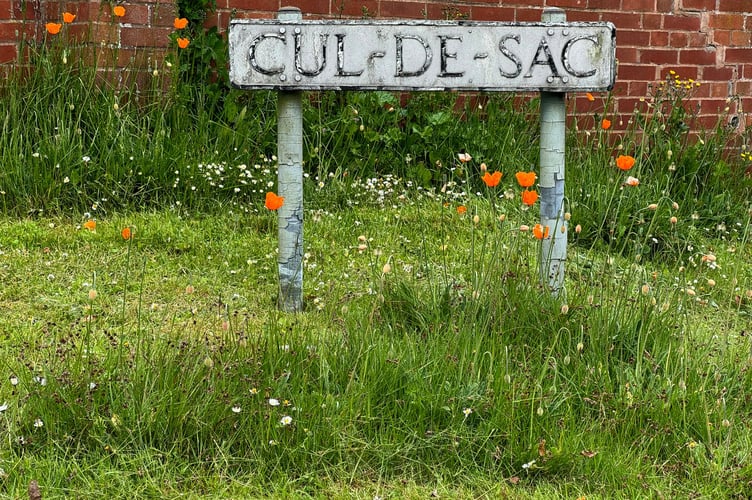
The wild orange poppies and daisies were left around the cul-de-sac sign for residents to enjoy.
Herefordshire Wildlife Trust- A Wildflower Meadow of Your Own
Is your lawn your pride and joy, sporting gorgeous stripes and cut to bowling green perfection? Or is it just a nuisance, making work for you in summer? Perhaps you’ve even contemplated putting down fake grass– stop there! Wherever you are on the spectrum of lawn love you can do something important for wildlife – and even yourself – by leaving your mower temporarily in the shed.
No Mow May is the slogan of charity Plantlife who campaign nationally for us to let our lawns bloom for insect life. They also work with councils to encourage a more relaxed cutting regime for roadside verges, parks and other spaces where close-cut grass is not needed. All these spaces are important, even tiny ones. The nation’s 23 million gardens make up a huge area of land. While conventional farming continues to allow so little room for wildflowers our gardens must do the work.
If you love a manicured lawn, could you nevertheless leave a strip un-mown during May and see if wild flowers appear? Even if you have made it your life’s work to eradicate daisies and dandelions, other more timid plants may still be present. They can provide vital nectar and pollen for bees and other insects. Clover is a lawn classic that will soon have bees humming all over it. It’s not until you allow a lawn a little breathing space that you get to see what else may be hiding among the grasses. People with long-established lawns may have a treat in store and even find orchids flowering for the first time.

For lovers of the classic lawn a scruffy-looking patch can be a painful sight. But a way to dignify your mini meadow is to mow around the edges and cut paths through if it’s big enough. Any neighbours looking askance over the fence may then understand it’s a deliberate plan. Perhaps if they appreciate how pretty your meadow strip is you’ll start a trend and more wildlife will benefit. Once the month is up and some plants have had a chance to flower you can resume your mowing regime, but if you’ve enjoyed the experiment perhaps you could leave it longer. All sorts of mowing regimes are possible to suit your lawn and the species living there. A great place to check these out is the Plantlife website https://www.plantlife.org.uk/campaigns/nomowmay/ where you can sign up your lawn to the No Mow May campaign.
When you do haul out the mower there’s a simple thing that will help your little meadow next year. Let the cut grass remain on the patch for a few days before raking it up and removing it so as to give the wildflower seeds a chance to drop. Taking away the cuttings later is important too: it prevents the lawn from becoming too rich in nutrients which favour the grassy thugs rather than the flowery folk.
Maybe at the end of the trial you’ll fall in love with your new-look lawn and decide to do it again next year. If you do you can be sure you’re really helping wildlife. If you’re already less enthusiastic about mowing there’s a double benefit to be had: your lawn helps nature and you do less work!
